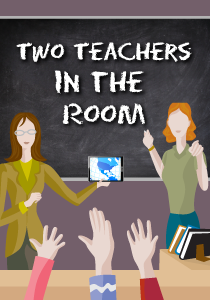How to Help Kids Become Self-Advocates
A MiddleWeb Blog

My last post was about the value of teaching executive functioning skills to guide students’ decision making and self-regulation. This week, let’s take the idea of empowering students even deeper.
Let’s consider providing our students with the experience of becoming strong self-advocates. Andrew Lee defines self-advocacy as “the ability to speak up for what you need.” These skills are typically taken for granted as teachers focus on their content area specialty. But co-teachers, don’t let that happen to you! Be mindful to empower your students to advocate for their own learning.

Many struggle with the language, social, or pragmatic skills needed to express their needs. Many students get used to well-intentioned (or just plain busy!) parents or teachers who end up enabling students by doing too much for them. So keep reading! And think about how you and your co-teacher may empower your students to truly take charge of their learning…and their lives.
Need more convincing? There is no better way to spend time than to take the next 3 minutes and 28 seconds (make sure you watch the whole thing; it’s worth it!) to check out Christopher’s Self-Advocacy Story in his own words.
Another inspiring student shares his voice in a huge way – check out his story: Anthony True Trains Other Students With Dyslexia to Self-Advocate. Oh, wait…one more thing before you read on…this post naturally embeds the power of Universal Design for Learning during the process and journey of self-advocacy.
Co-Teaching with Advocacy
Given the wide range of learner variability, co-teachers have the additional responsibility to provide opportunities for each student to express his or her needs. We must promote self-sufficiency, resiliency, and persistence so our students leave our classrooms with the skills and belief systems that make it possible for each student to say, “I am capable” and “I can find solutions.” So what can co-teachers do? Let’s consider four strategies:
- Put students at the center of learning
Incorporate self-discovery and acceptance. Make sure that you are promoting experiences that encourage students to believe in themselves. Embed Universal Design for Learning in ways that allow students to focus on learning goals while exploring the information and materials in ways that are personally meaningful.
One way to begin this journey is by having students create a T-Chart where they list their interests and strengths on the left and the areas they feel they would like to improve on the right. This simple technique can open up the doors for powerful learning ahead as you work to design instruction around your students’ views of themselves.
Wait! You can take this exercise one step further using multiple means of expression by having students choose how they would like to share this T-Chart. Let them choose between ideas such as developing their T-Chart or creating a visual poster, poem, speech, Prezi, or podcast – the options for expression are boundless here. These options will also do wonders for student engagement and self-discovery. You just may have a part in uncovering a hidden student talent!
- Co-create environments conducive to seeking solutions

- Review a student’s IEP on an individual basis
Make time for one teacher to sit with each student to review his or her IEP. Encourage the view of themselves as learners through a strengths-based lens. Review the present levels of performance and areas of strengths and needs as stated in the IEP. Make sure to ask the student what he thinks about what you just shared – you will learn so much about your student in these moments.
In addition, review the student’s goals and testing accommodations, and any program accommodations or modifications. Explain how the information in this document supports and empowers this student’s abilities. Then, as students get older, they become better and better advocates for themselves by explaining to teachers what they need in order to learn best or what supports make test taking a positive experience.
- Recognize strengths while embracing needs
Keep the focus on variability not disability. How can you design instruction to keep each student’s abilities at the center of the learning? How can you create the context for lessons so that students may use their strengths to anchor their learning?
As you plan instruction in this way, you will find students are comfortable seeking solutions when they feel confused. They will be inspired to ask for help, seek out resources, and share what they think about the topic of learning. Check out these examples of addressing learner variability through UDL.
From Self-Discovery to Self-Advocacy
Self-advocacy begins with guiding our students through a journey of self-discovery and self-acceptance. It’s natural to be confused or to struggle with learning – we all feel this way sometimes because it is a natural part of any learning process. Through our explicit support and curriculum design, we can optimize our classroom learning environments so each learner is truly free to speak UP for himself or herself. Ultimately, for most of our students, this sense of freedom will extend beyond the moments spent in our classrooms.
How are you creating the space to empower your students’ voices and advocacy skills?


































